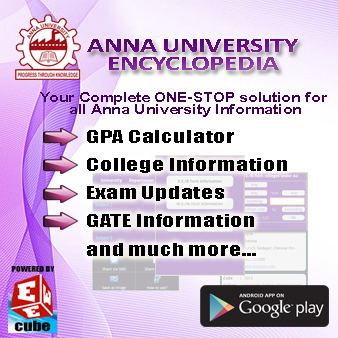SUBJECT RESOURCES:
CLICK HERE to access 'Question Banks'
CLICK HERE to access 'Previous Year Question Papers'
CLICK HERE to access 'Question Bank & 2 Mark Questions with Answers'
CLICK HERE to search more about this subject
CLICK HERE to access 'Question Banks'
CLICK HERE to access 'Previous Year Question Papers'
CLICK HERE to access 'Question Bank & 2 Mark Questions with Answers'
CLICK HERE to search more about this subject
SYLLABUS:
EE2351 POWER SYSTEM
ANALYSIS L T
P C
3 1 0
4
AIM
To understand the necessity and to become familiar with the modelling of power system and
components. And to apply different methods to analyse power system
for the purpose of system planning and operation.
OBJECTIVES
i To model the power system under steady state operating condition. To apply efficient numerical methods to solve the power flow problem.
ii. To model and analyse the power systems under
abnormal
(or) fault conditions.
iii. To model and analyse the transient behaviour of power system when it is subjected to a fault.
UNIT I INTRODUCTION 9
Modern power
system (or) electric energy system - Analysis for system
planning and operational
studies
–
basic
components of
a
power system.
Generator models
-
transformer
model –
transmission system model - load representation. Single line diagram – per phase and per unit representation – change of base. Simple building algorithms for the formation of Y-Bus matrix and Z- Bus matrix.
UNIT II POWER FLOW
ANALYSIS 9
Importance of power flow analysis in planning and operation of power systems. Statement of power
flow problem - classification of buses into P-Q buses, P-V (voltage-controlled) buses and slack
bus.
Development of Power flow model in complex variables form and polar variables form.
Iterative solution using Gauss-Seidel method including Q-limit check for voltage-controlled buses –
algorithm and flow chart.
Iterative solution using Newton-Raphson (N-R) method (polar form) including Q-limit check and bus
switching for voltage-controlled buses -
Jacobian matrix elements – algorithm and flow chart.
Development of Fast Decoupled Power Flow (FDPF) model and iterative solution – algorithm and flowchart;
Comparison of the three methods.
UNIT III FAULT ANALYSIS – BALANCED FAULTS 9
Importance short circuit (or) for fault analysis - basic assumptions in fault analysis of power
systems. Symmetrical (or) balanced three phase faults – problem formulation – fault analysis using Z-bus matrix – algorithm and flow chart. Computations of short circuit capacity, post fault voltage and currents.
UNIT IV FAULT ANALYSIS – UNBALANCED FAULTS 9
Introduction to
symmetrical
components
–
sequence
impedances
–
sequence
networks
–
representation of single line to ground, line to line and double line to ground fault conditions.
Unbalanced
fault
analysis
-
problem
formulation – analysis
using Z-bus
impedance
matrix
–
(algorithm and flow chart.).
UNIT V STABILITY ANALYSIS 9
Importance of stability analysis in power system
planning and operation - classification of power
system
stability - angle and voltage stability – simple treatment of angle stability into small-signal
and large-signal (transient)
stability
Single Machine Infinite Bus (SMIB) system: Development of swing equation - equal area criterion -
determination of critical clearing angle and time by using modified Euler method and Runge-Kutta second order method. Algorithm and flow chart.
TOTAL: 45 PERIODS
TEXT BOOKS:
1. Hadi
Saadat, ‘Power System
Analysis’, Tata McGraw Hill Publishing Company, New
Delhi, 2002.
2. Olle. I. Elgerd, ‘Electric Energy Systems Theory – An Introduction’, Tata McGraw Hill
Publishing Company Limited, New Delhi, Second Edition, 2003.
REFERENCES:
1. P. Kundur, ‘Power System Stability and Control, Tata McGraw Hill, Publications,
1994.
2. John J. Grainger and W.D. Stevenson Jr., ‘Power
System Analysis’, McGraw Hill
International Book Company, 1994.
3. I.J. Nagrath and D.P. Kothari, ‘Modern Power System Analysis’, Tata McGraw-Hill
Publishing Company, New Delhi, 1990.
4. .K.Nagasarkar and M.S. Sukhija Oxford University Press, 2007.
|
|










No comments:
Post a Comment
Note: Only a member of this blog may post a comment.